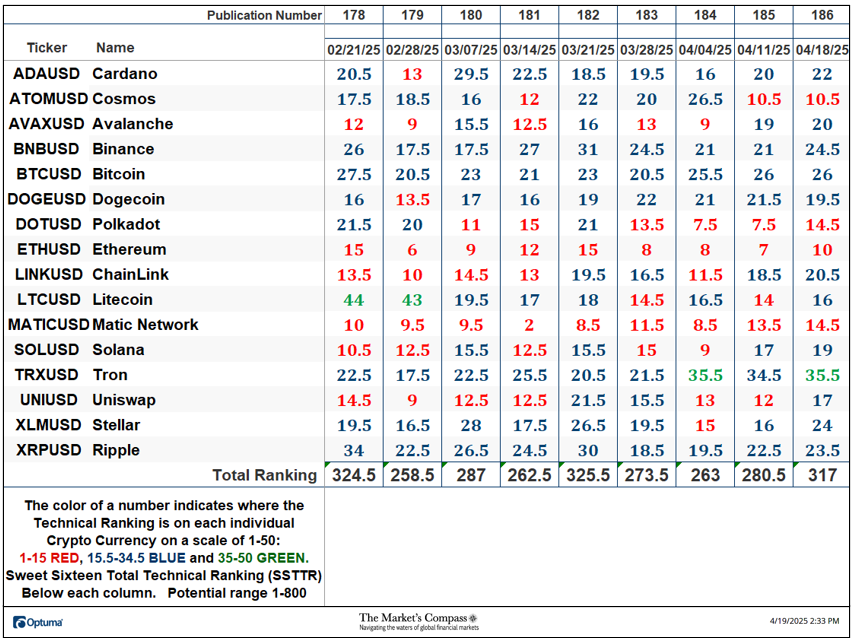Welcome to the inaugural publication of the Market’s Compass Weekly Crypto Sweet Sixteen Study. The Study tracks the technical condition of sixteen of the larger market cap cryptocurrencies. I have compiled the historic quantitative objective technical ranking data and secondary technical indicators including the Sweet Sixteen Total Technical Rankings and Weekly Average Technical Ranking back to October of 2021. Every week the Studies will highlight the technical changes of the 16 cryptocurrencies that I track as well as individual highlights on noteworthy moves in certain cryptocurrencies.
This Week’s and 10 Week Trailing Technical Rankings of the 16 Individual Cryptocurrencies
The Market's Compass Technical View is a reader-supported publication. To receive new posts and support my work, consider becoming a free or paid subscriber.
The Excel spreadsheet below indicates the weekly change in the objective Technical Ranking (“TR”) of each individual Cryptocurrency. The technical ranking or scoring system is an entirely quantitative approach that utilizes multiple technical considerations that include but are not limited to trend, momentum, measurements of accumulation/distribution and relative strength. If an individual Cryptocurrency’s technical condition improves the Technical Ranking (“TR”) rises, and conversely, if the technical condition continues to deteriorate, the TR falls. The TR of each individual Cryptocurrency can range from 0 to 50. The spreadsheet below also acts as a “heat map” in that, cryptocurrencies with a TR in the range of 1 to 15 are highlighted in red, 15.5 to 34.5 are noted in blue and TRs in the range of 35 to 50 are in green. The primary take-away from this spread sheet should be the trend of the individual TRs, either the continued improvement or deterioration, as well as a change in direction. A sustained trend change needs to unfold in the individual TRs for it to be actionable. Secondarily a very low ranking can signal an oversold condition and conversely a continued very high number can be viewed as an overbought condition but, as we know, over sold conditions can continue at apace and overbought securities that have exhibited extraordinary momentum can easily become more overbought. Thirdly, the weekly TRs are a valuable relative strength/weakness indicator vs. each other, in addition when the Sweet Sixteen Total Technical Ranking (“SSTTR”), that has a range of 0 to 800, is near the bottom of its range and an individual cryptocurrency has a TR that remains elevated it speaks to relative strength. Conversely if the SSTTR is near the top of its recent range and an individual cryptocurrency has a TR that remains mired at low levels it speaks to relative weakness. Lastly I view the objective Technical Rankings as a starting point in my analysis and it is not the entire “end game”.
The individual and total technical weakness in Cryptocurrencies into the end of December 2021 can be seen in the week ending December 30th. During the weeks that followed going into February there was better and consistent readings. A singular example of superior relative technical strength was Litecoin which held at a high TR level in the green zone for the first 7 weeks of the New Year. This was by exhibiting positive relative technical strength vs. the other 15 with Litecoin by remaining in the “green zone” (TRs between 35 and 50) over that period. Its improvement was not alone up until the end of February but it was a noteworthy hint to dig deeper into Litecoin’s technicals at that time.
The Sweet Sixteen Total Technical Ranking (“SSTTR”) plateaued in late February and pulled back four weeks ago before the recent improvement in the technical condition in all Sixteen TRs.
As can be seen above at the end of last week there were six Cryptocurrency TRs in the “green zone”, nine were in the “blue zone” (15.5 to 34.5) and one (Cosmos) remained in the “red zone”.
This was versus the week before when there were five Cryptocurrencies in the “green zone”, nine were in the “blue zone” and two were in the “red zone”. The average TR gain on the week was +4.88.
Twelve Cryptocurrency TRs improved on a WoW basis with Cardano registering the best TR improvement by gaining +15.5 “handles” to 39.5 from 24 (see chart and technical comments below).
After overtaking resistance at the Kijun Plot (green line) a week ago last Tuesday Cardano rallied further but was capped by resistance at the top of the Cloud. Early last week the Kijun Plot served as support on the price retracement and prices drove higher through the “twist” in the Cloud continuing the rally from the March 10th low. MACD (panel below price) reflects the improving upside price momentum as the oscillator enters positive territory while tracking higher above its signal line. This has been in concert with improved relative strength vs. the CCi30 Index* (green arrow lower panel). I expect that the early February price reversal at the 0.42 level to at the very least to offer a measure of resistance.
*The CCi30 Index is a registered trademark and was created and is maintained by an independent team of mathematicians, quants and fund managers lead by Igor Rivin. It is is a rules-based index designed to objectively measure the overall growth, daily and long-term movement of the blockchain sector. It does so by tracking the 30 largest cryptocurrencies by market capitalization, excluding stable coins (more details can be found at CCi30.com).
Further Measurements of Relative Strength and Weakness in the Sweet Sixteen“What’s in Your Wallet?”
A look at the relative strength/weakness of the Sweet Sixteen versus the CCi30 Index
There has been a steady continued improvement in relative strength in number of Crypto Sweet Sixteen that can be seen above including but not limited to Bitcoin, Ethereum, Ripple, Stellar, and the aforementioned Cardano.
Relative Rotation Graph of the Sweet Sixteen
The Relative Rotation Graph, commonly referred to as RRGs were developed in 2004-2005 by Julius de Kempenaer. These charts are a unique visualization tool for relative strength analysis. Chartists can use RRGs to analyze the relative strength trends of several securities against a common benchmark, (in this case the CCi30 Index) and against each other over any given time period (in the case below daily since the end of the end of last week. The power of RRG is its ability to plot relative performance on one graph and show true rotation. All RRGs charts use four quadrants to define the four phases of a relative trend. The Optuma RRG charts uses, From Leading (in green) to Weakening (in yellow) to Lagging (in pink) to Improving (in blue) and back to Leading (in green). True rotations can be seen as securities move from one quadrant to the other over time. This is only a brief explanation of how to interpret RRG charts. To learn more see the post scripts at the end of this Blog.
Ripple is by far the strongest of all of the Sweet Sixteen as it charges higher in the Leading Quadrant to an almost unsustainable level, followed closely by Stellar. I prefer to look at Tokens that just entering the Leading Quadrant from Improving that are just starting to gain relative strength, this in an attempt to get the “most bang from our buck”. Both Cardano and Litecoin are two examples. Those four which have, or are improving, are at the expense both Bitcoin and Ethereum which are beginning to weaken.
Seven Day Absolute Price Change of the Sweet Sixteen*
*Measured Friday to Friday
The Technical Condition Factor changes since the week ending December 30th There are eight Technical Condition Factors (“TCFs”) that determine individual TR scores (0-50). Each of these 8, ask objective technical questions (see the spreadsheet posted above). If a technical question is positive an additional point is added to the individual TR. Conversely if the technical question is negative, it receives a “0”. A few TCFs carry more weight than the others such as the Weekly Trend Factor and the Weekly Momentum Factor in compiling each individual TR of each of the 16 Cryptocurrencies Because of that, the excel sheet above calculates each factor’s weekly reading as a percent of the possible total. For example, there are 7 considerations (or questions) in the Daily Momentum Technical Condition Factor (“DMTCF”) of the 16 Cryptocurrencies ETFs (or 7 X 16) for a possible range of 0-112 if all 16 had fulfilled the DMTCF criteria the reading would be 112 or 100%.
This past week a 80.36% reading in the DMTCF was registered for the week ending March 31st, or 90 of a possible total of 112 positive points. Five weeks before the DMTCF reading had fallen to a oversold reading of 3.57% or 4 of 112 positive points. The current reading leaves the DMTCF approaching the short-term overbought range between 85% and 100%. It should be remembered that when it is in the range of 0% to 15% it suggests an short term over sold condition has developed, as it did 5 weeks ago.
As a confirmation tool, if all eight TCFs improve on a week over week basis, more of the 16 Cryptocurrencies are improving internally on a technical basis, confirming a broader market move higher (think of an advance/decline calculation). Conversely, if more of the TCFs fall on a week over week basis, more of the “Cryptos” are deteriorating on a technical basis confirming the broader market move lower. Last week 6 TCFs rose and two fell confirming the move higher in the broader Cryptocurrency market.
The CCi30 Index with This Week’s Sweet Sixteen Total Technical Ranking “SSTTR” Overlaid
The Sweet Sixteen Total Technical Ranking (“SSTTR”) Indicator is a total of all 16 Cryptocurrency rankings and can be looked at as a confirmation/divergence indicator as well as an overbought oversold indicator. As a confirmation/divergence tool: If the broader market as measured by the CCi30 Index continues to rally without a commensurate move or higher move in the SSTTR the continued rally in the CCi30 Index becomes increasingly in jeopardy. Conversely, if the CCi30 Index continues to print lower lows and there is little change or a building improvement in the SSTTR a positive divergence is registered. This is, in a fashion, is like a traditional A/D Line. As an overbought/oversold indicator: The closer the SSTTR gets to the 800 level (all 16 Cryptocurrencies having a TR of 50) “things can’t get much better technically” and a growing number individual Crypto’s have become “stretched” there is more of a chance of a pullback in the CCi30. On the flip side the closer to an extreme low “things can’t get much worse technically” and a growing number of Crypto’s are “washed out technically” and an oversold rally or measurable low is closer to being in place. The 13-week moving average in Red smooths the volatile SSTTR readings and analytically is a better indicator of trend.
The CCi30 Index 9-month base building process continues. That price action has been in concert with improving price momentum as witnessed by MACD which has continued to track high above its signal line as the momentum oscillator approaches positive territory. I believe that with the March 10th higher low in price and the on going confirmation of the Sweet Sixteen Total Technical Ranking 13-Week Moving Average (red line) since the turn of the year that the CCi30 Index will easily challenge price resistance at last June/July highs at the 10,000 /11,000 level in the weeks ahead.
The Sweet Sixteen Index Daily Line Chart with the Sweet Sixteen Daily Momentum Oscillator
The Sweet Sixteen Daily Momentum Oscillator is the total of the 16 Cryptocurrency Daily Momentum Technical Condition Factors. It serves as a shorter-term confirmation/non-confirmation and overbought/oversold indicator of the price changes in the Sweet Sixteen Crypto Index and is used in conjunction with MACD.
I have only one budding short-term technical concern, that is revealed in the chart above. The Sweet Sixteen Daily Momentum oscillator has not yet confirmed the move higher in the Index despite the higher lows and higher highs in price (yellow dotted line in price and momentum panel). Only time will tell if the divergence with MACD (which continues to track higher in positive territory) will be resolved.
Charts are courtesy of Optuma whose charting software enables anyone to visualize any data including RRG Charts and our Objective Technical Rankings.
The following links are an introduction and an in depth tutorial on RRG Charts…
https://www.optuma.com/videos/introduction-to-rrg/
https://www.optuma.com/videos/optuma-webinar-2-rrgs/
To receive a 30-day trial of Optuma charting software go to…
www.optuma.com/TMC.
tbrackett@themarketscompass.com
The Market's Compass Technical View is a reader-supported publication. To receive new posts and support my work, consider becoming a free or paid subscriber.





















